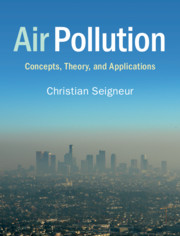Book contents
- Air Pollution
- Air Pollution
- Copyright page
- Contents
- Preface
- Main Notations
- 1 Brief History of Air Pollution
- 2 Emissions of Air Pollutants and Emission Control Technologies
- 3 Meteorology: General Circulation
- 4 Air Pollution Meteorology
- 5 Atmospheric Radiative Transfer and Visibility
- 6 Atmospheric Dispersion
- 7 The Stratospheric Ozone Layer
- 8 Gaseous Pollutants
- 9 Atmospheric Particles
- 10 Clouds and Acid Rain
- 11 Transfer of Pollutants between the Atmosphere and Surfaces
- 12 Health Effects
- 13 Environmental Impacts
- 14 Climate Change and Air Pollution
- 15 Regulations and Public Policies
- Index
- References
6 - Atmospheric Dispersion
Published online by Cambridge University Press: 19 June 2019
- Air Pollution
- Air Pollution
- Copyright page
- Contents
- Preface
- Main Notations
- 1 Brief History of Air Pollution
- 2 Emissions of Air Pollutants and Emission Control Technologies
- 3 Meteorology: General Circulation
- 4 Air Pollution Meteorology
- 5 Atmospheric Radiative Transfer and Visibility
- 6 Atmospheric Dispersion
- 7 The Stratospheric Ozone Layer
- 8 Gaseous Pollutants
- 9 Atmospheric Particles
- 10 Clouds and Acid Rain
- 11 Transfer of Pollutants between the Atmosphere and Surfaces
- 12 Health Effects
- 13 Environmental Impacts
- 14 Climate Change and Air Pollution
- 15 Regulations and Public Policies
- Index
- References
Summary
Atmospheric dispersion is a very important process in air pollution. The use of tall stacks to minimize the impacts of air pollutant emissions reflected the saying that “the solution to pollution is dilution.” Although this saying turned out to be wrong for several reasons, including the cumulative effect of a large number of individual sources and the formation of secondary pollutants at large regional scales, atmospheric dispersion is nevertheless one of the key processes that govern air pollution levels. This chapter presents the fundamental processes of atmospheric dispersion, their theoretical basis, as well as the advantages and shortcomings of different types of atmospheric dispersion models.
- Type
- Chapter
- Information
- Air PollutionConcepts, Theory, and Applications, pp. 95 - 124Publisher: Cambridge University PressPrint publication year: 2019
References
- 1
- Cited by



